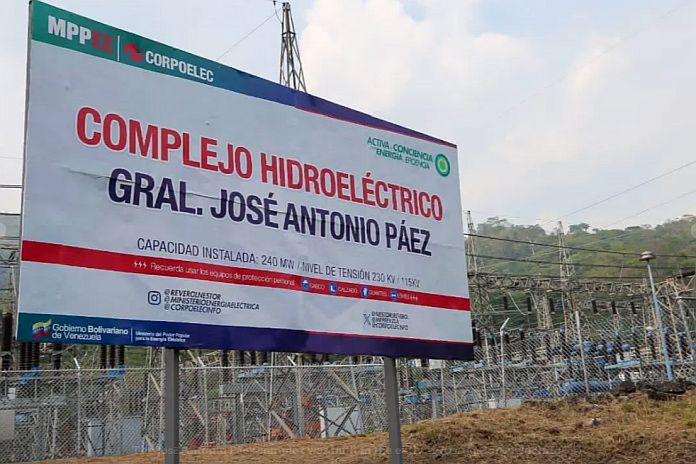- The renewed dam complex operations aim to reduce frequent power blackouts in Apure, Barinas, Mérida and Táchira states.
By Ricardo Vaz
CARACAS, (venezuelanalysis.com) – Venezuelan authorities announced the reactivation of the General José Antonio Páez Hydroelectric Complex in Barinas state.
Several state officials, including electricity minister Néstor Reverol, toured the facility on Sunday before giving a press conference. With two turbines in operation, the plant will supply 120 megawatts (MW) to the electricity grid.
“The [Venezuelan] people have suffered as a result of the US blockade and sanctions,” Reverol told reporters. “But we continue to resist: these works will have an important impact on the region’s well-being.”
The minister added that authorities plan to activate two other turbines by the end of April to reach the complex’s maximum capacity of 240 MW.
Mérida governor Jehyson Guzmán was also present and highlighted the Nicolás Maduro government’s efforts to address public service issues.
“The efforts with the 1×10 system [to report and address public service problems] are starting to deliver,” he said. “In spite of difficulties, including due to the climate crisis, we are going to continue working to improve the electricity supply.”
The José Antonio Páez hydroelectric plant is located close to the border between Barinas and Mérida states and is supplied by the Santo Domingo and Aray rivers. Built in the early 1970s, it had operated in a stop-start fashion in recent years, despite several maintenance operations, to compound electricity shortages in the Caribbean nation’s western states.
The dam was restarted after four months of intensive repair works. Apart from the recovery of the turbine systems, state electricity company CORPOELEC reported that its personnel had updated equipment in the adjacent substation, rebuilt a wall on the dam’s canal and removed more than a million cubic feet of sediment from the Santo Domingo reservoir.
The reactivated hydroelectric complex will boost the electrical supply to Apure, Barinas, Táchira and Mérida states. Located in western Venezuela, they have been the most heavily affected by power blackouts in recent times.
Social media users and Venezuelanalysis sources have reported that electricity outages often take place more than once on the same day for multiple-hour periods. The lack of information about the rationing schedule has likewise fueled discontent.
Venezuela’s National Electric System (SEN) remains heavily reliant on the 10,000 MW-capacity Simón Bolívar Hydroelectric Plant, known as the Guri dam, located in Bolívar state, eastern Venezuela.
An electricity crisis in 2009 saw the Hugo Chávez government draw up plans to expand supply with other sources throughout the country. However, the ensuing economic crisis, as well as corruption cases, some of which have been prosecuted, saw many of the major works unfinished.
US sanctions heavily compounded the issue, blocking possibilities to service equipment and secure spare parts. Fuel shortages, aggravated in 2020 when the Trump administration targeted crude-for-fuel swap agreements, also rendered a number of diesel-powered plants inactive.
Venezuela suffered multiple countrywide blackouts in 2019, which the Maduro government attributed to terrorist attacks against the electric system.
In the past five years, CORPOELEC has managed to shore up the grid to avoid simultaneous issues on a national scale. While in the capital Caracas and other central areas electricity shortages have become very uncommon, rationing remains the norm in most parts of the country. Low water levels in dams worsen the supply in Western Venezuela states.
While authorities have not provided data on the state of the electric system, analysts have speculated that the high-voltage transmission lines from the Guri dam are not in optimal shape.





